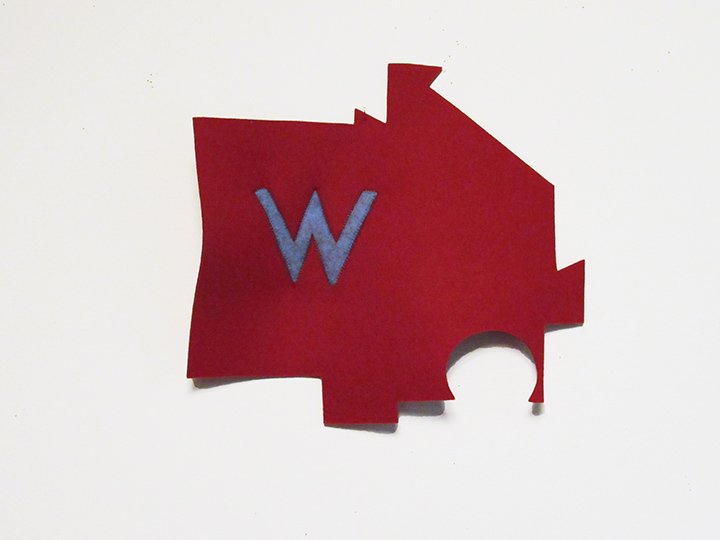CYRILLA MOZENTER | Problems of Art | WAITING ROOM
January 19 - February 28, 2025
Problems of Art is a selection of hand stitched industrial wool felt freestanding and wall works made in a twenty year span.
The process of making throughout is improvisational. Hand stitching wool felt creates stress. The felt buckles, torques, droops, and stretches in unpredictable response, requiring attentiveness, flexibility, as well as a sense of playful adventure in ever-changing circumstance. The suspense of the process applies not only to form but also to color. As felt shapes are stitched together, cut edges soften and meld, shadows between disappear. Color relationships may shift dramatically. What looks harsh or dissonant at one moment in the process, transforms to harmonious in another.
Felt is a textile of ancient origin made from matted and consolidated tangles of animal fur suggesting compressed chaos. Unlike the grid of woven, felt is the fabric of irrationality. An insulator, the felt I use is thick, dense, and quieting—soft to the touch, with a matte, impressionable, non-reflective surface. The silk thread with which I stitch, is lustrous, refined. Both materials derive from creatures.
The earlier freestanding works are from More saints seen, shown in a grouping of 30 primarily vessel forms, suggestive of sacred ritual objects, and with related works on paper at the Aldrich Museum in 2005. They are made with cream-color felt (with small touches of black or grey), pencil marked and studded with toothpicks, wooden ice cream spoons, buttons, pearls, and beads. While felt absorbs liquid, vessels by definition are able to contain it. These vessels cannot function as such, but instead have an absurd pale presence, that of ghosts or resurrected memories of these elemental and essential forms.
More recent felt wall works involve the transplantation of cutout letters, letter-derived, and pictogram-like shapes that serve to activate irregularly shaped felt 'grounds' suggesting flags, banners, and pennants. In the works on exhibition, some of the letter forms are not overt, informing the contour of a shape in one instance or in absence as a letter-shaped open space in another. Like the 'saints,' the inlaid shapes are iconic and, in this context, can bring to mind medieval heraldry. The wall works are not flat; they hover in a space between two and three dimensions. Shapes are cut out and then inlaid (and stitched) into position not unlike marquetry, requiring exactness. The spiraling tension of the hand stitching causes subtle dimensional flare-ups that further animate the work. A doomed attempt at regularity, the stitching is in opposition to the chaos that is felt. It is a form of physical drawing. Much of the work begins with cast-offs or remains of earlier pieces: cutout shapes and the grounds from which they have been cut with untidy edges 'as is' suggesting history and the desire for repair and renewal.
WAITING ROOM
CYRILLA MOZENTER | Present Participle
November 11 - December 17, 2021
“I hand stitch industrial wool felt to make both freestanding and wall pieces in established processes that include the transplantation of cutout letters, letter-derived, and pictogram-like shapes. These shapes are cut out and then inlaid (and stitched) into position not unlike marquetry, requiring exactness. The stitching necessitates a devotional stitch-by-stitch attentiveness, causing unpredictable dimensional flare-ups that further animate the work. This doomed attempt at regularity contrasts with the compressed chaos that is felt.
My involvement with icons and symbols (of my own devising) runs consistently through all my work. I see letters as ideal forms with iconic power. They need to have lives of their own, aside from being 'team players' in forming words and sentences. I mouth their sounds as I work. (Wool felt, like snow, is an insulator and therefore quieting.) I am both performer and audience.
My works are evidence of the experience of making them. Nothing is not important. That includes quality of gesture. The gestures emanate from impulses that could be seen as alternately reckless and lady-like.
The process of making my work is an adventure. I appreciate getting lost. I'm not interested if I know the way. If I don't know either the way or the ultimate destination, I have to be attentive to the subtlest clues that the process reveals. And to chance (help from the outside). I watch. What does the work want to be? What is it calling for me to do? Do I dare? What needs to be turned upside down, inside out or backwards? If I have pre-conceptions, I subvert them. I want to be surprised. I am, though, looking for a quality of inevitability. (A lawfulness.) That it couldn't have been any other way, given me and my materials in that space and time.“ - CM
Cyrilla Mozenter is known for her gouache-painted, pencil-drawn (and written) works on paper and hand stitched industrial wool felt freestanding and wall pieces that include the transplantation of cutout letters, letter-derived and pictogram-like shapes. These works hover in the space between two and three-dimensions. Many of the titles and words that appear in the work come from Gertrude Stein’s writing. They are playful and absurd, defying singular interpretations. Solo exhibitions include See Why and the failed utopian, Lesley Heller Gallery, NY; the failed utopian & Other Stories, FiveMyles, Brooklyn; warm snow, Adam Baumgold Gallery, NY, and the Garrison Art Center, Garrison, NY; More saints seen, The Aldrich Contemporary Art Museum, Ridgefield, CT; and Very well saint, The Drawing Center, NY. Octave, her bilingual collaborative book with photographer Philip Perkis was published in 2020 by anmoc press, Seoul. A 2020 Guggenheim Fellow, she has also received two fellowships from the NY Foundation for the Arts and two project grants from The Fifth Floor Foundation. She has been in residence at Pianpicollo Selvatico, Dieu Donné Papermill, and Instituto Municipal de Arte e Cultura-Rioarte. Her work is in numerous public collections including the Brooklyn Museum and the Yale University Art Gallery. She taught for many years in the MFA program at Pratt Institute.



